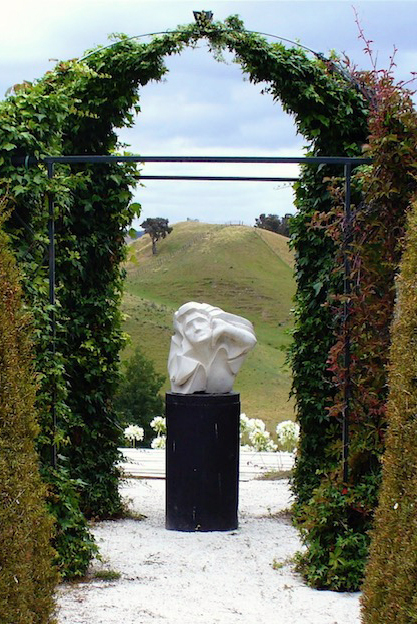Marcus Helmore – an artistic legacy set in stone
26 Nov 2024
Stone sculptor, hill country farmer, and College Old Boy Marcus Helmore (6899) continues to carve out a three-dimensional career.
A Richards House boarder from 1959–1962, Marcus “comes from a family of artists”.

“We once had an exhibition in Hastings with 11 members over three generations contributing,” he recalls. “Both my grandmothers also painted and now my son, Joe (12047), has a career as a contemporary painter.”
Now living in Waimārama, Marcus has “just completed a successful sculpture exhibition as part of the annual Hawke’s Bay Art Guide over two weekends”.
Utilising the guide, members of the public can visit the artist’s studio. Marcus’s 12 limestone pieces were displayed in the Clifton Woolshed owned by fellow Richards House Old Boy and farmer Angus Gordon (7558).
“Limestone was formed from marine life more than 25 million years ago under the sea, and when I carve a piece, I always have the feeling of bringing the stone back to life,” Marcus explains. “I like to carve pieces that have a sense of movement and flow, especially the aerodynamic beauty of birds.
“Before starting, I try and visualise the piece from every angle, but continually make changes as the piece develops.
“I was always keen on art and did School Certificate Art with Mr Aitchison at College, and I think I won the Art prize in 1962,” Marcus recalls.
He believes that “‘Aitchy” was a good art teacher and engaging storyteller.
“With every new boys' art class, he would demonstrate and encourage class participation. He would clip a large sheet of art paper on an easel and paint it all over in very dark blue, then paint a series of dots in orange, yellow, and red in an arc all over. He would then turn to the class and ask – ‘What do you think this painting is about?’
“When the class ran out of ideas, he would say ‘light flack over Germany’. For the rest of the period, Aitchy would tell the spellbound class about his time in Bomber Command during World War II. It didn’t have much to do with art but the boys were keen to return to art classes next time.”
He also enjoyed the “dry humour” of then Headmaster Reg Hornsby.
“I remember one occasion at lunch in the Dining Hall when Hornsby was at the head of our table and made a leading statement – ‘I hope you realise that I will be coming up with you on the railcar at the end of the term to speak at the Old Boys’ dinner at the Napier Club’. To which I blurted out ‘but Sir, the North Island has a particularly good bus service’. I thought I had gone too far but he roared with laughter. He got his own back by writing an end of term report describing me as ‘a likeable individualist who has successfully managed to avoid me this term’.
Post-school, Marcus’s “main career was as a hill country farmer in the foothills of the Ruahine Ranges in west Hawke’s Bay”.
“On leaving College I went shepherding but art was very much my hobby,” he says. “I had a passion for cartooning and character drawing in those early years. I did some advertising work and illustrated a book with cartoons.”
However, his artistic outlook underwent a big change in the late 1980s, when Marcus did a stone-carving course with Martin Selman and found a passion for sculpture.

“We carved with Oamaru limestone but Mount Somers stone was recommended as it was more dense, enabling a much finer edge to sculpture pieces,” he says. “Fortunately, I had spent a year shepherding for Leo Chapman (3085) on Inverary Station, Mount Somers, more than 20 years earlier.
“I played rugby for Mount Somers in 1966 and when I came to order some stone from the quarry years later, the quarry manager turned out to be my team halfback. He said ‘I’ll pick you out the best boulders’, putting 12 tonne on a truck and trailer, and sending it all the way up to the farm in Hawke’s Bay. That’s how I got started and have had more than 30 years carving – masked and covered in dust. I still have more than a tonne left.
“I have taken part in several stone-carving symposiums, with one in Mount Somers in 2008 being the most memorable. One of my pieces, a Picasso-like figure, sits in the Mount Somers Domain.”
On retiring from farming, Marcus and his wife, Chris, moved to a beach house at Waimārama, where he built a studio.
“I joined an artists’ collective gallery in Napier and exhibited my sculptures there for eight years,” he says. “I have also spent time tutoring young students in stone carving during their school craft week. It is the three-dimensional aspect of sculpture that they find hardest to grasp. I get them to continually move around their piece so it looks right from every angle.”
Marcus also continues to catch up with his College community, both in Hawke’s Bay and at school reunions. He is among the many Helmore generations who have walked through the College gates.
“Three of my greatgrandfathers went to College, including Thomas Albert Philips (77) in 1858, and two of my grandfathers, William Harry Helmore (882) 1879–1882, who won the open mile, and Kenneth Struthers Williams (1779) 1897–1898. In my wider family, there have been several great uncles and cousins at College, with the most notable being College Fellow – and 1884 national rugby representative – George Henry Noble Helmore (665) 1876–1879, whose portrait can be found in the Dining Hall, and his son, well-known architect Heathcote George Helmore (2261) 1906–1912.”

